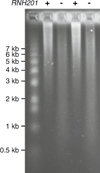Measuring ribonucleotide incorporation into DNA in vitro and in vivo
- PMID: 25916710
- PMCID: PMC5321556
- DOI: 10.1007/978-1-4939-2596-4_9
Measuring ribonucleotide incorporation into DNA in vitro and in vivo
Abstract
Ribonucleotides are incorporated into genomes by DNA polymerases, they can be removed, and if not removed, they can have deleterious and beneficial consequences. Here, we describe an assay to quantify stable ribonucleotide incorporation by DNA polymerases in vitro, and an assay to probe for ribonucleotides in each of the two DNA strands of the yeast nuclear genome.
Figures



References
-
- Li Y, Breaker RR. Kinetics of RNA degradation by specific base catalysis of transesterification involving the 2′-hydroxyl group. J Am Chem Soc. 1999;121:5326–5372.
-
- Asturias FJ, Cheung IK, Sabouri N, Chilkova O, Wepplo D, Johansson E. Structure of Saccharomyces cerevisiae DNA polymerase epsilon by cryo-electron microscopy. Nat Struct Mol Biol. 2006;13:35–43. - PubMed
Publication types
MeSH terms
Substances
Grants and funding
LinkOut - more resources
Full Text Sources
Other Literature Sources
Molecular Biology Databases

